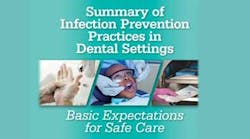CDC releases summary of latest infection control practices in dental settings
In a press conference held March 29, Jennifer Cleveland, DDS, OSAP lead for infectious diseases and infection prevention in dental health-care settings, Dr. John O'Keefe, OSAP chairman of the board, and Therese Long, executive director of OSAP, gathered to explain the update.
"The report highlights the need for compliance in the dental setting," said Dr. Cleveland. "This is a significant new resource that complements and supplements the 2003 summary. It's more of a repackaging of the 2003 document, not a replacement. It provides more in-depth information for dental practices on ways to comply."
When asked what they hope to stress with the update, Dr. Cleveland explained. "We hope these tools and additional resources will be of value to all dental personnel in all types of dental settings to ensure adherence to infection control recommendations," she said. "The importance of complying with standard precautions for preventing the transmission of infectious organisms cannot be stressed enough.
"Finally, we encourage all dental practices to appoint a dedicated staff person in charge of infection control," Dr. Cleveland added. "This person will become educated in infection control compliance and ensure that everything is in place for adherence within the practice. That's where the new and updated checklists are so valuable. They are a very important companion to the summary."
The Organization for Safety, Asepsis and Prevention (OSAP) recognizes the importance of these CDC documents and supports CDC’s efforts to guide the profession to provide the safest care possible. To this end, OSAP has created an array of tools and resources at osap.org specifically designed to help dental teams understand and comply with the CDC guidelines.
EXCLUSIVE INTERVIEW WITH CDC OFFICER |CDC official discusses infection control guidelines: Dr. Michele Junger describes the agency's resources
As a trusted source of information for dental educators, consultants, clinicians, researchers, and policymakers, OSAP provides timely updates, advanced education, innovative training tools, referenced answers to vexing infection control questions, and proven strategies to address compliance challenges. The organization has custom-designed tools and resources to help the dental team put the CDC guidelines into practice. These include:
• From Policy to Practice: OSAP's Interactive Guide to the CDC Guidelines, a free online course with seven modules that break the guidelines down into easily understood principles.
• CDC Guidelines: From Policy to Practice by OSAP, a self-study workbook that walks users through the CDC guidelines. Each chapter contains practical how-to instructions, charts and checklists, pictures and captions, answers to common questions, and guidance for making sound clinical judgments.
• OSHA & CDC Guidelines: Interact Training System, a program that combines requirements for OSHA annual training with the CDC Guidelines.
• OSAP Dental Infection Control Educators' & Trainers' Toolkit, a coaching workbook delivered via CD and designed to assist with the development, planning, and promotion of successful, high-impact infection control and safety programs and presentations.
In addition, OSAP will keep the dental profession informed using social media, member publications such as InfoBites, expert advice via Ask OSAP, web forums, and special programming at the OSAP Boot Camp, the annual OSAP conference, and national dental meetings. OSAP will also work with consultant, educator, and corporate members, and coordinate with other dental organizations to help inform the dental community.
MORE ON INFECTION CONTROL |FDA proposes ban on most powdered medical gloves
Dental practitioners and other interested parties are encouraged to check the OSAP website frequently and become a member of OSAP to receive timely updates on new resources and gain access to additional educational opportunities as they become available.
Celebrating more than 30 years of service to the worldwide dental community, OSAP is a growing community of clinicians, educators, students, policy-makers, and industry representatives who advocate for safe and infection-free delivery of oral healthcare. OSAP focuses on strategies to improve compliance with safe practices and on building a strong network of recognized infection control experts to help dental professionals ensure that every visit is The Safest Dental Visit for patients and the dental team.

